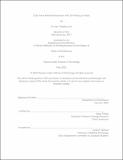2.5D: Novel Material Dimensions with 3D Printing on Fabric
Author(s)
Lee, En-Han Thaddeus
DownloadThesis PDF (9.397Mb)
Advisor
Tibbits, Skylar
Terms of use
Metadata
Show full item recordAbstract
Much of the design for architecture and objects we encounter today is built around the paradigms for manufacturing either two dimensional, flat goods, or three dimensional forms. We achieve an astounding proficiency in producing paper, fabric or sheet goods, whilst often encountering the familiar problem of logistics and assembly in creating anything in three dimensions. What if we were to combine the proficiency we have with the former, to produce volume, form, and structure?
2.5D is a proposal for a hybrid approach that applies 3D printing onto textiles and film material. The resultant method hopes to meld the design vocabularies of 2D and 3D design whilst presenting new possibilities with existing materials and technologies. Building on preceding research in 4.154 Interactive Intelligent Skins, this thesis takes the body as the most immediate context for architecture to present three objects as case studies.
The first is a reformable bag that suggests how fabric behavior might be modified with 3D printing. The second, a therapeutic garment that explores new materialities for variable flexibility and structure. And last, a shoe concept that addresses possibilities of mass customization and distributed manufacturing.
Responding to the challenges faced in the design of these, this thesis also puts forth a prototype design for a wide-format 3D printer capable of working with novel flexible filaments in the context of roll-to-roll textile and film manufacturing. When coupled with the techniques presented, this approach offers the tantalizing possibility to manufacture objects with complex structures and material behaviors, but in a manner that achieves accessibility with high volume output at relatively low costs.
Date issued
2022-05Department
Massachusetts Institute of Technology. Department of ArchitecturePublisher
Massachusetts Institute of Technology